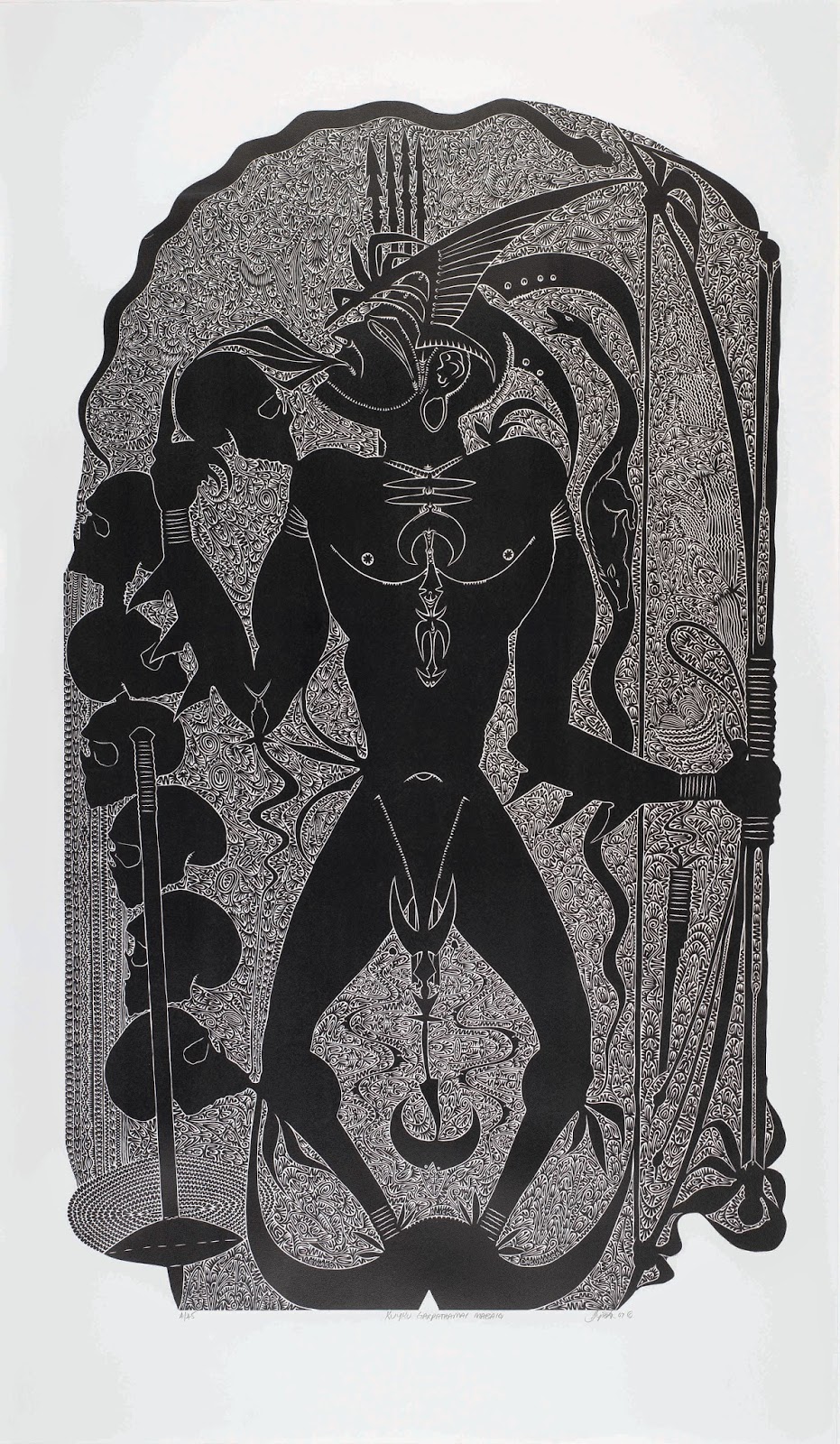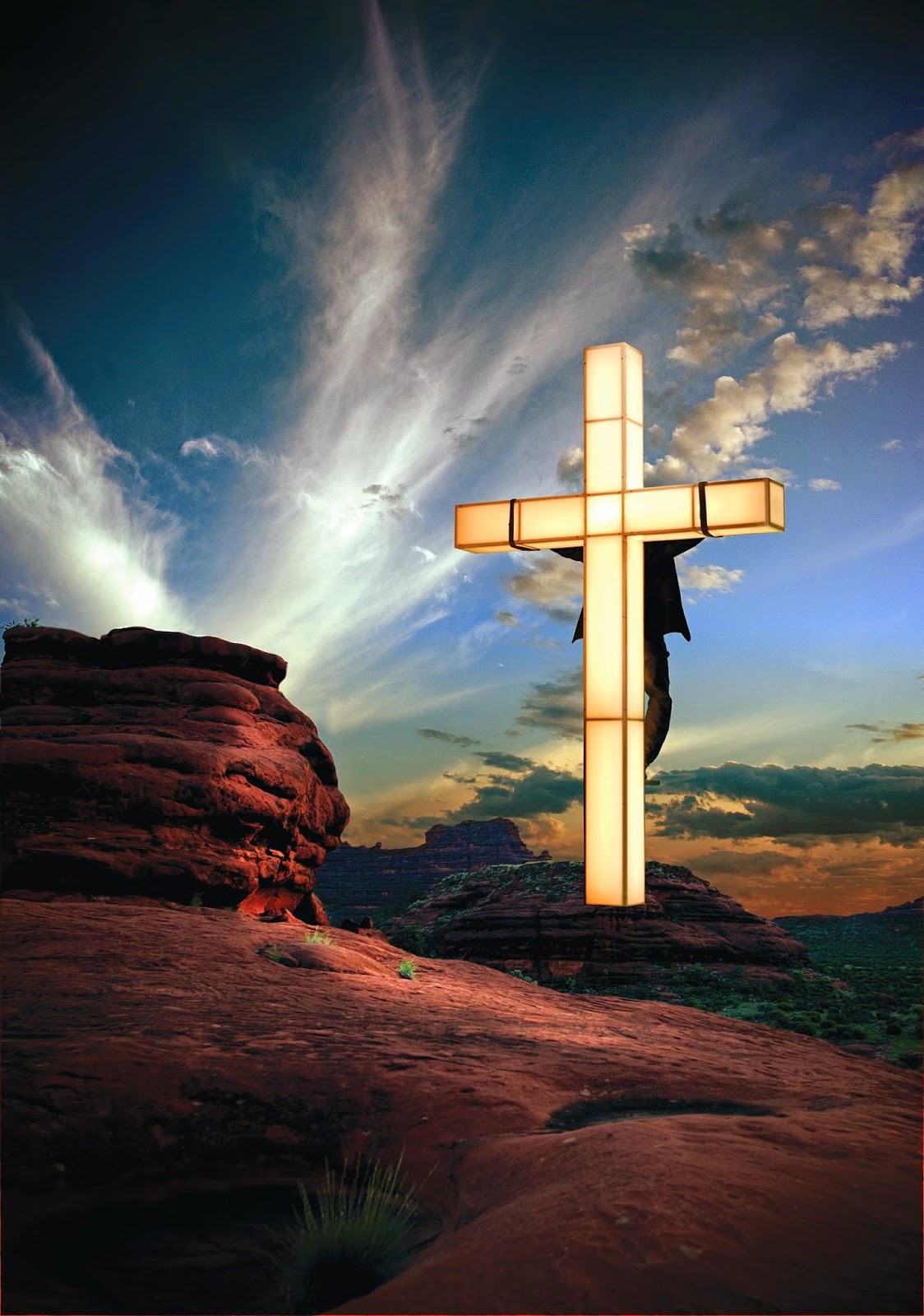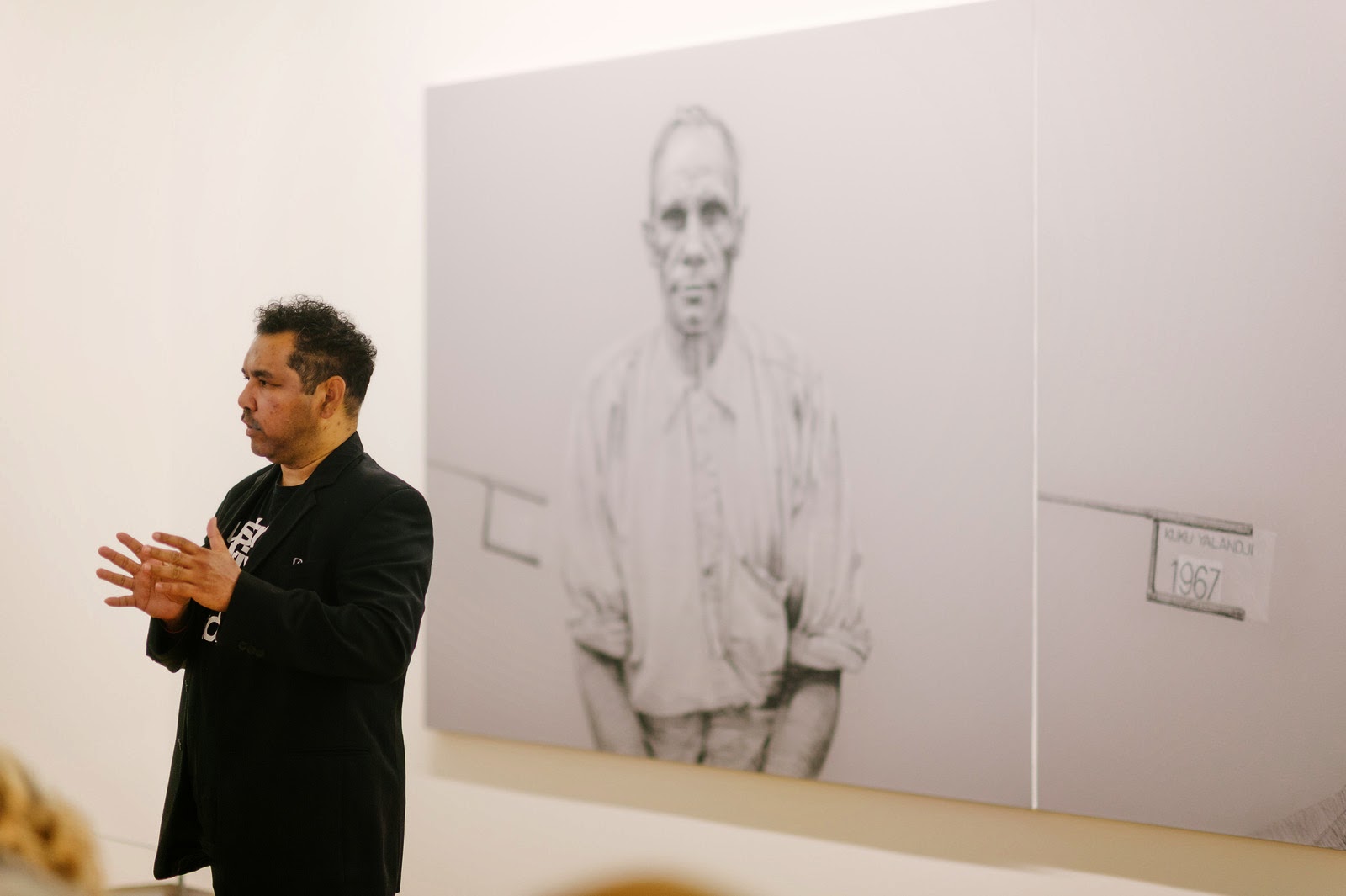Thursday 31 July 2014
Zara Stanhope
Visitors to My Country: Contemporary Art from Black Australia often express surprise at the innovative nature of Australian Indigenous art, and that contemporary art by Indigenous Australians includes more than abstract painting. Urban, art school trained artists create work in every media imaginable. Artists from remote areas are recognised for taking traditional practices – sand drawing, body painting, decoration of burial poles and functional objects – and reconceiving them in new and fresh ways, while conveying the importance of the mythological and recent history of their land and politically declaring Indigenous rights.
In this blog I want to explore the ways in which the artists in My Country are groundbreaking and, in particular, how their innovation is endorsed by the awards and acknowledgements they have received.

Alick Tipoti, Kukyu Garpathamai Mabaig 2007
Alick Tipoti is from Torres Strait and his work in My Country exemplifies the acclaimed status of artists in the exhibition. Tipoti is an expert in linocut printing (a Western technique that he has helped to introduce to islanders). Tipoti has developed an extremely creative and articulate style of print making, which conveys his traditional culture to his people and to the rest of the world. He was Student of the Year during his art training (1993), and since then his works have attracted a list of accolades, including over five annual National Aboriginal and Torres Strait Islander Art Awards, culminating in the Senior Artist Award and Artist of the Year in 2012. In 2011 Tipoti also won the British Council’s Indigenous Leadership Award. His amazing work in My Country, Kuyku Garpathamai Mabaig, 2007, which depicts a head hunter with his weapons communicating with the spirit of his victims, won the Freemantle Print Award.
Genevieve Grieves is a young artist from New South Wales. She is representative of younger generations of Indigenous artists who have grown up in urban areas, gone to art school and who use contemporary media in their art making. Grieves five-channel video Picturing the Old People, 2006–7 is based on archival studio photographs of Indigenous people. Picturing the Old People won the Xstrata Coal Emerging Indigenous Art Award 2007. Making these videos at the age of 30, Grieves worked collaboratively to include relatives of the people depicted in the original images in her animation and disruption of the historical photos.

Warwick Thornton, Stranded 2011
Distance within the huge Australian continent, or from the rest of the world, is no deterrent to talent. Internationally acclaimed Indigenous Film maker Warwick Thornton was brought up in Alice Springs, and as a teenager lived in Australia’s only monastic town (New Norcia, WA). His 2009 film Samson and Delilah won Caméra d’Or at the Cannes Film Festival in 2009, when Thornton was in his late thirties. While continuing his directing career, Thornton was commissioned by Telstra to make a work the for 2011 Adelaide Film Festival. He created the hard-hitting yet beautiful 3D film Stranded, 2011, which is presented in My Country and is his only work made for a gallery space.
Youth, however is not a perquisite for Indigenous Australian achievement in contemporary art, as works by numerous artists in My Country demonstrate. The painting Euro tracks, 2011 by Dickie Minyintiri won the 28th National Aboriginal and Torres Strait Islander Award in 2011, out of over 300 entries. This subtle painting of multiple layers and colours represents Minyintiri’s personal memory of travel in his country and expresses his ancestral relationship to the land in the stories of a sacred men’s ceremonial site. Amongst the network of lines are traces of the tracks of ancestral spirits (kangaroos, dogs, emu) to important waterholes.
This decorated artist reinforces the ageless nature of success. At almost 100 years old (born 1915) Minyintiri is the oldest artist in Ernabella, SA, and his paintings are found in all the Australian state galleries. The formal painting career of this senior man, responsible for many traditional laws, only began in 2005 when Dickie was almost 90.
Eighty-eight-year-old Sally Gabori won the inaugural $50,000 Gold Award presented by Rockhampton Art Gallery in 2012 with a painting similar to but smaller than her work Dibirdibi Country, 2008, in My Country. More remarkable is that Gabori commenced painting only five years earlier. She rapidly followed this success by winning the Togart Contemporary Art Award 2012 and seeing her work enter many public gallery art collections including, the Musée de Quay Branley in Paris. Gabori paints the shoreline where she grew up on Bentnick Island, northern Queensland, a home from which missionaries removed her and her family in 1948.
My Country includes art by the key figures who established a creative and economic pathway for others, especially women.
One such entrepreneurial artist is Emily Kngwarreye, whose work Wild Potato Dreaming, 1990 appears in My Country. Born in 1910, Kngwarreye ignored the impediments of distance and social and economic disadvantage to succeed in taking up painting as a career, commencing her art practice just prior to reaching the age of 80. Kngwarreye was living in the community of Utopia, 350 kilometres north-east of Alice Springs. The medium of acrylic on canvas was only introduced to Utopia in 1988. Kngwarreye’s paintings of her yam dreaming, which she said include ‘everything’ (meaning her ancestral links, the aspects of culture she has custodianship over and the country where she lives) have set new records for the price and national and international recognition of Aboriginal art in general.
Australian Indigenous people had not adopted the European materials of paint and canvas until 1971 when school teacher Geoffrey Bardon introduced these art tools to men in the Papunya community, located 250 kilometres west of Alice Springs. When Kngwarreye began painting in 1989 she forged her own style which was distinct from that of the men painting in Papunya. By 1990, she had five solo exhibitions and 12 group exhibitions in Australia – a trailblazing feat by a woman who had not left the central desert area of the continent before beginning her art career. Prime Minister Paul Keating acknowledged Kngwarreye’s achievements when he presented her with the Australian Artists Creative Fellowship in 1992, making her the first Indigenous artist to receive this prestigious award.
In remote parts of Australia painting is a way in which Indigenous people stay connected to culture, and provides an occasion for singing ancestral and past stories, and a time to pass down knowledge and carry on custodial duties in regard to land. Australia was, as you will know, presumed to be terra nullius or land belonging to no one by the colonial settlers who arrived in the 18th century. The paintings of Kngwarreye, like other artists, have broken new ground in demonstrating evidence of a prior connection to country, and have been accepted as evidence in Land Trials. In this way, painting has assisted communities, including Utopia, to gain freehold title to their territory.
My Country is indicative of the fact that there is no single characteristic of professional and economic achievement. The photos Black Gum, 2008, which reflect on colonial perceptions of Indigenous Australians, are by Christian Thompson, the first Aboriginal Australian to be admitted to Oxford University in its 900-year history.

Vernon Ah Kee speaking in front of his work, neither pride nor courage 2006, at Auckland Art Gallery, Saturday 29 March 2014
Vernon Ah Kee recently won the 2014 Redlands Konica Minolta Art Prize for the style of charcoal drawing on canvas that is seen in his large triptych neither pride nor courage, 2006 in My Country. The third part of this triptych shows the face of the future – it is a portrait of Ah Kee’s son. This boy exemplifies changes since the artist’s own start in life – Ah Kee was born in 1967, just before a referendum in which Aboriginal Australians were granted the right to vote, and the first time they became full citizens in their own land.
The artists in My Country indicate the many ways in which art can be a means to not only survive but also flourish. Through their art these artists acknowledge the importance of past and current communities in contemporary life, and engage others with culture in new and inventive ways. I leave you with an image of the installation I Forgive You, 2012 by Bindi Cole, an artist who had won the Victorian Indigenous Art Awards in 2007 and 2009 when she was in her early thirties. Made from thousands of emu feathers, I Forgive You is literally – and figuratively – multi-layered. One meaning that we can take from this work, and from other art in My Country, is that the success and integrity of any person is interconnected with those who form our worlds and countries.
Additional notes:
Richard Bell
A painting very similar to Richard Bell’s Theorum (Tricky Dicky and Friends) on view in My Country won Bell the National Telstra Indigenous Art Award (2003).
Michael Cook
Artist of the Civilised series, photographer Michael Cook, is a two-time winner of the National Aboriginal and Torres Strait Islander Awards in recent years.
Image credits:
Alick Tipoti
Kala Lagaw Ya people
Australia QLD b.1975
Kuyku Garpathamai Mabaig 2007
Purchased 2008. The Queensland Art Gallery Foundation Grant
Warwick Thornton
Kaytej people
Australia NT b.1970
Stranded 2011
Purchased 2011. Queensland Art Gallery Foundation
Vernon Ah Kee
Kuku Yalanji/Waanyi/Yidinyji/Guugu Yimithirr people
Australia QLD b.1967
neither pride nor courage 2006
The James C Sourris, AM, Collection.
Gift of James C Sourris through the Queensland Art Gallery Foundation 2007. Donated through the
Australian Government's Cultural Gifts Program